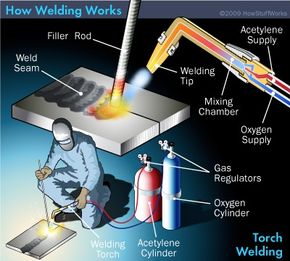Creating a Welding WPS: Step-by-Step Instructions for Professionals
Creating a Welding WPS: Step-by-Step Instructions for Professionals
Blog Article
Getting Welding Excellence: Unveiling the Tricks of WPS Implementation and Optimization
In the world of welding, achieving excellence is a quest that pivots on the careful implementation and optimization of Welding Treatment Specifications (WPS) By diving into the key aspects, techniques, difficulties, and ideal practices connected with WPS, a world of welding quality waits for those that are eager to discover its depths.
Importance of WPS in Welding
The Significance of Welding Procedure Specifications (WPS) in the welding industry can not be overstated, serving as the backbone for guaranteeing consistency, high quality, and security in welding procedures. A WPS supplies in-depth guidelines on just how welding is to be accomplished, consisting of necessary variables such as products, welding processes, joint layout, filler metals, interpass and preheat temperatures, welding currents, voltages, travel rates, and more. By sticking to a well-defined WPS, welders can preserve harmony in their job, bring about regular weld top quality throughout various jobs.

Trick Components of WPS
Going over the essential components of a welding treatment spec (WPS) is important for understanding its duty in welding operations. A detailed WPS consists of several crucial elements that direct welders in accomplishing top quality and consistency in their job. One vital facet of a WPS is the welding procedure specification, which describes the specific welding processes to be made use of, such as gas tungsten arc welding (GTAW) or shielded metal arc welding (SMAW) Furthermore, the WPS consists of information on the welding materials, such as the type and specs of the base steel and filler steel to be used. The WPS also specifies necessary variables like welding criteria, preheat and interpass temperature demands, and post-weld warm therapy procedures. In addition, it consists of information on joint design, fit-up, and any unique methods or preventative measures necessary for the welding operation. By incorporating these essential aspects into the WPS, welding treatments can be standardized, ensuring high quality, efficiency, and safety and security in welding procedures.
Methods for WPS Optimization

Second of all, training and certification of welding employees according to the specific requirements of the WPS is vital. Giving comprehensive training programs and guaranteeing that welders are accredited to carry out treatments laid out in the WPS can result in better welds and minimized rework.
In addition, leveraging innovation such as welding software application and surveillance systems can assist in maximizing WPS. These devices can aid in tracking variables, ensuring parameters are within specified limits, and offering real-time comments to welders, enabling them to make instant modifications for enhanced weld high quality.
Typical Difficulties and Solutions
Facing barriers in carrying out the methods for WPS optimization can impede welding operations' efficiency and top quality. One usual obstacle is insufficient training or understanding of the welding procedure requirements (WPS) amongst the welding team.
Another obstacle is the lack of proper documents and record-keeping, which is necessary for WPS optimization. Without clear documents of welding specifications, materials used, and inspection outcomes, it becomes tough to determine areas for renovation and make certain consistency in welding processes. Applying a durable paperwork system, such as digital welding monitoring software application, can help enhance record-keeping and facilitate information analysis for constant improvement.
Furthermore, inconsistent welding devices calibration and maintenance can position a significant obstacle to WPS optimization. Routine equipment checks, calibration, and upkeep timetables ought to be followed strictly to make certain that welding parameters are properly controlled and preserved within the defined tolerances (welding WPS). By resolving these common difficulties with aggressive services, welding procedures can enhance effectiveness, top quality, and general welding quality
Best Practices for WPS Application
To make certain effective WPS application in welding operations, adherence to industry requirements view publisher site and thorough attention to information are critical. When launching WPS implementation, it is important to start by completely comprehending the certain welding demands of the project. This involves a thorough review of the welding procedure specs, products to be bonded, and the ecological conditions in which the welding will certainly happen.
Once the requirements are clear, the next step is to choose the proper welding procedure that aligns with these specs. This includes getting in touch with the appropriate codes and standards, such as those given by the American Welding Society (AWS) or the International Organization for Standardization (ISO), to ensure compliance top article and high quality.
In addition, recording the whole WPS execution procedure is crucial for traceability and quality control. Detailed records should be kept regarding welding parameters, material preparation, preheat and interpass temperatures, welding consumables utilized, and any type of variances from the initial procedure. Routine audits and reviews of the WPS can help identify locations for renovation and make certain recurring optimization of the welding procedure.


Verdict
In final thought, the implementation and optimization of Welding Treatment Specifications (WPS) is critical for accomplishing welding quality. By comprehending the key aspects of WPS, implementing efficient strategies for optimization, resolving common obstacles, and following finest techniques, welders can ensure top notch welds and risk-free working problems. It is vital for specialists in the welding industry to focus on the correct execution of WPS to enhance general welding efficiency and achieve preferred end results.
The Importance of Welding Treatment Requirements (WPS) in the welding industry can not be overstated, offering as the foundation for guaranteeing uniformity, top quality, and safety in welding operations. A WPS supplies thorough instructions on exactly how welding is to be lugged out, consisting of important variables such as materials, welding procedures, joint layout, filler steels, preheat and interpass temperatures, welding currents, voltages, travel rates, and extra. One crucial aspect of a WPS is the welding process spec, which details the particular learn this here now welding procedures to be utilized, such as gas tungsten arc welding (GTAW) or secured steel arc welding (SMAW) By incorporating these crucial aspects into the WPS, welding procedures can be standardized, guaranteeing high quality, efficiency, and safety in welding procedures.
It is critical for professionals in the welding industry to prioritize the proper implementation of WPS to enhance overall welding performance and achieve preferred results.
Report this page